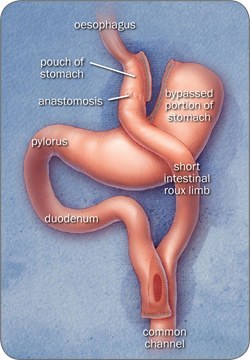Gastric bypass

The surgeon creates this pouch using metal staples that are similar to stitches. The stomach will be cut through so that the pouch is no longer attached to the rest of the stomach. The top section of the stomach (the pouch) will hold your food.
The surgeon will count down 75–150cm from the top of your small intestine and divide it. They will then bring up the end that is not attached to your remaining stomach and attach it to the pouch.
Food will now travel from the pouch straight into the small bowel. The divided end of the small bowel that is connected to the remainder of your stomach is then connected 75–150cm below where the other end is joined to the gastric pouch.
This allows the digestive juices (gastric and pancreatic juices) to enter the small intestine and digest the food.
As with the gastric band, the main effect is that the amount of food you are able to eat is reduced. Therefore you will fill up quickly and stay full for longer (after only a few mouthfuls of food).
Most people find that they do not get the same feeling of hunger that they did before the surgery.
The bypassed portion of stomach and intestine does not affect the absorption of most of the nutrients that you eat. However it may reduce the amount of protein, vitamins and minerals that you absorb.
To avoid developing a deficiency, we will prescribe vitamin and mineral supplements for you to take daily for life. We will also take regular blood tests to ensure you do not develop any nutritional deficiencies.
Expectations of weight loss
Most people lose weight quite quickly over the first year following bypass surgery. You will generally reach your target weight after 18 months.
On average, people lose 65–75% of their excess body weight. As with gastric band surgery, there is variation in the amount of weight that people lose following surgery.
Adherence to dietary advice will result in greater weight loss and better weight maintenance. The dietitian will discuss with you what changes you would need to make to your eating patterns to have the best weight loss results.
Advantages
- The amount of food you can eat is restricted
- You are likely to feel fuller quicker and stay fuller for longer
- Weight loss starts from the time of surgery
- Weight loss tends to be faster than following the gastric band
- You can lose on average 65–75% of your excess weight
- The average weight loss after surgery tends to be higher than after a purely restrictive procedure (eg the gastric band)
- It is unusual for a patient not to lose the expected amount of weight
- The gastric bypass procedure is particularly effective at reducing medication requirements and improving blood sugar control for patients affected by Type 2 Diabetes Mellitus*
*A recent analysis showed resolution of diabetes in 81% of patients 2 years after surgery, and in 71% of patients less than 2 years after surgery (Buchwald et al 2007 American Journal of Medicine)
Disadvantages
- The surgery has more risks than the gastric band because it is a longer procedure and the stomach and intestines are cut
- Obstruction can occur where the new joins are created at the pouch and further down the intestine—this may require a procedure (endoscopic or surgical) to widen the area and allow food to travel through at the correct rate
- You will need to take daily multivitamin and mineral supplements for life
- You will be at greater risk of suffering from nutritional deficiencies such as vitamin B12, iron and calcium
- Your hair may thin although this is temporary while losing weight at a rapid rate
- You may develop gallstones due to rapid weight loss—it may be necessary to undergo a further operation to remove your gallbladder, although this is quite rare
- You may experience dumping syndrome, a condition which occurs if you eat too much sugar, fat or alcohol, or large amounts of food—it is not considered a health risk, but can be very unpleasant with symptoms including nausea, vomiting, diarrhoea, sweating, faintness, weakness and increased heart rate
- Nausea and vomiting may occur, particularly in the first few days after surgery—vomiting is also common if you eat too quickly or eat too much
- You will have better results if you follow dietary changes

